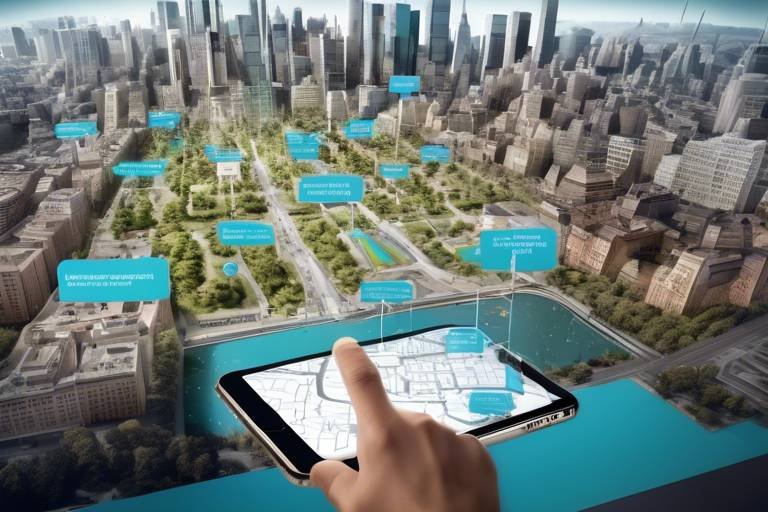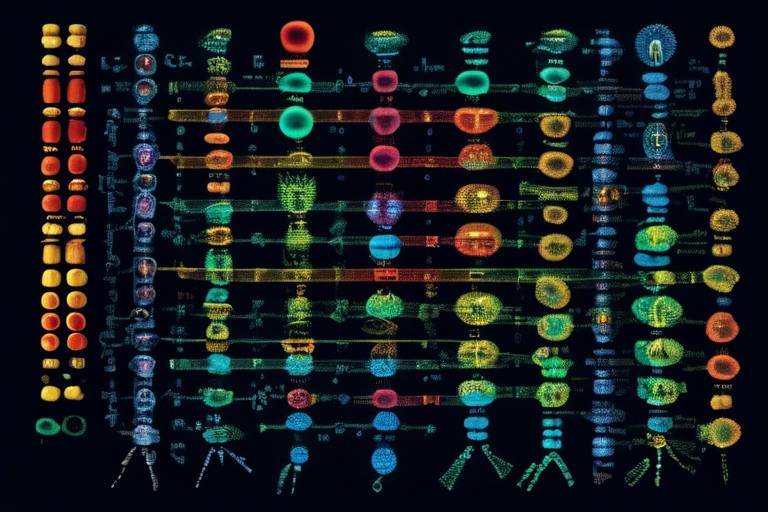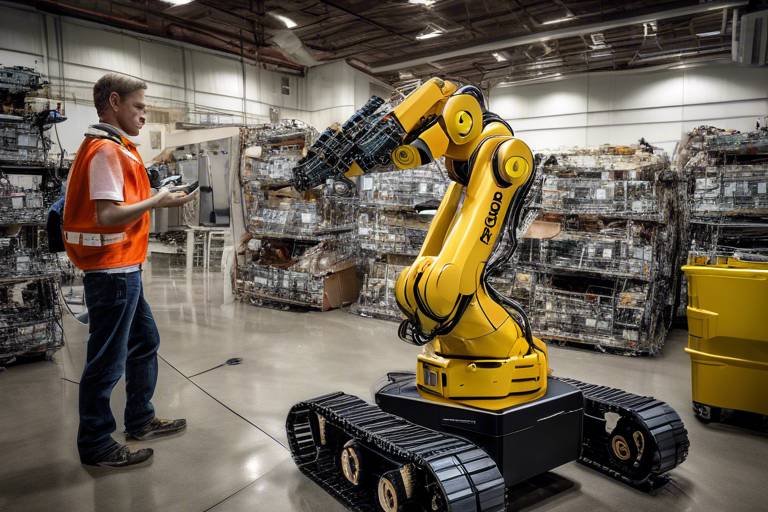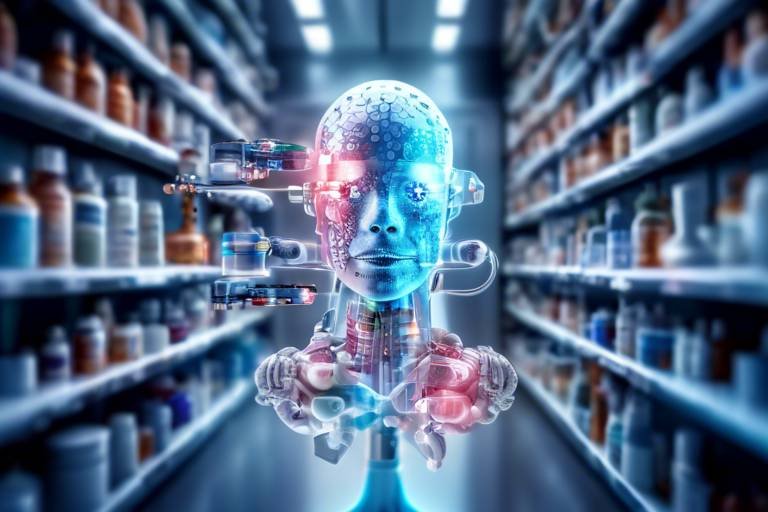The Role of Augmented Reality in Scientific Training
In today's rapidly evolving educational landscape, augmented reality (AR) is taking center stage, revolutionizing how scientific training is delivered. Imagine being able to conduct a chemistry experiment without the fear of spills or explosions, or visualizing complex biological processes in 3D right in your classroom. This is not just a distant dream; it's happening now! AR technology is bridging the gap between theoretical knowledge and practical application, making learning not only more engaging but also more effective.
As we delve deeper into the realm of AR in scientific education, it's essential to understand its transformative potential. Traditional teaching methods often leave students grappling with abstract concepts, but AR provides a dynamic and interactive platform that enhances comprehension. By overlaying digital information onto the physical world, AR creates immersive experiences that captivate students' attention and foster a deeper understanding of complex scientific principles.
Moreover, the implementation of AR in scientific training is not limited to just one discipline; its applications span across various fields, including biology, chemistry, physics, and environmental science. For instance, students can explore the intricate structure of DNA through interactive 3D models or simulate chemical reactions without the constraints of a physical lab. This flexibility not only enriches the learning experience but also prepares students for real-world scientific challenges.
In the following sections, we will explore the specific applications of AR in scientific training, the benefits it offers, and the challenges that educators may face in integrating this technology into their curricula. So, buckle up as we embark on this exciting journey into the future of education!

Understanding Augmented Reality
Augmented Reality, or AR, is a fascinating technology that bridges the gap between the digital and physical worlds. Imagine walking through a museum where the paintings come to life, or conducting a science experiment without the need for a laboratory. That’s the magic of AR! It overlays digital information—like images, sounds, and sensory inputs—onto our real-world environment, creating an interactive experience that enhances our understanding of complex subjects.
At its core, AR operates on a few fundamental principles. It uses a combination of hardware and software to recognize the real world around us. Devices like smartphones, tablets, and AR glasses are equipped with cameras and sensors that detect physical objects and their surroundings. Through sophisticated algorithms, AR then superimposes digital content onto these real-world elements. This process not only makes learning more engaging but also provides a multi-dimensional perspective that traditional methods simply can't match.
In the context of scientific training, AR serves as a powerful tool to facilitate hands-on learning. For instance, students can visualize molecular structures in 3D, manipulate them, and observe their interactions in real-time. This kind of immersive experience is invaluable for grasping complex scientific concepts that can often feel abstract or difficult to understand. By engaging multiple senses, AR helps learners to better absorb information, making it a game-changer in education.
Moreover, AR can cater to different learning styles. Some students might thrive on visual stimuli, while others may prefer auditory explanations or kinesthetic activities. With AR, educators can create tailored experiences that meet the diverse needs of their students. This adaptability not only enhances the learning experience but also promotes a more inclusive environment where everyone has the opportunity to succeed.
As we delve deeper into the world of AR in scientific training, it's essential to recognize its potential to revolutionize education. The technology is not just about flashy graphics or cool gadgets; it’s about transforming how we learn and interact with the world around us. By integrating AR into the curriculum, educators can prepare students for a future where technology and science go hand in hand, fostering a generation of innovators and thinkers.

Applications of AR in Scientific Training
Augmented Reality (AR) is not just a buzzword; it's a revolutionary tool that's reshaping how we approach scientific training. Imagine walking into a classroom where the periodic table doesn't just hang on the wall but comes to life, illustrating the properties of each element in vivid detail right before your eyes. This is the power of AR—bringing the abstract into the tangible. As we dive into the applications of AR in scientific training, we'll uncover how this technology is being harnessed across various disciplines to create immersive learning experiences that were once the stuff of science fiction.
One of the most significant applications of AR in scientific training is the use of virtual laboratories. These virtual labs allow students to conduct experiments in a digital space that simulates real-world lab environments. Students can mix chemicals, observe reactions, and even troubleshoot equipment—all without the risks associated with traditional labs. This innovation not only enhances safety but also encourages experimentation and exploration. Imagine a student conducting a complex chemistry experiment without the fear of spills or accidents; this is the reality AR brings to the table.
Furthermore, AR supports interactive simulations that deepen students' understanding of intricate scientific concepts. For instance, in biology, students can use AR to visualize cellular processes, such as mitosis or photosynthesis, in a three-dimensional space. This immersive experience allows learners to grasp complex ideas that would be challenging to understand through textbooks alone. The ability to manipulate these visualizations fosters a deeper comprehension and retention of knowledge, making learning not just effective, but also enjoyable.
Let's take a closer look at how AR is applied across different scientific disciplines:
| Discipline | AR Application | Benefits |
|---|---|---|
| Chemistry | Virtual Lab Experiments | Safe experimentation, cost-effective |
| Biology | 3D Cellular Visualization | Enhanced understanding of complex processes |
| Physics | Interactive Physics Simulations | Real-time feedback, improved problem-solving skills |
In addition to enhancing learning outcomes, AR also promotes accessibility and inclusivity. Students with disabilities can benefit from tailored learning experiences that accommodate their unique needs. For instance, AR applications can provide visual aids for hearing-impaired students or interactive content for those with learning disabilities. This inclusivity ensures that every student has the opportunity to engage with scientific concepts in a way that resonates with them.
As we continue to explore the applications of AR in scientific training, it's clear that this technology is not just a trend but a transformative force in education. By bridging the gap between theoretical knowledge and practical application, AR is paving the way for a new era of learning that is interactive, engaging, and most importantly, effective.

Virtual Laboratories
Virtual laboratories powered by augmented reality (AR) are revolutionizing the way students engage with science. Imagine being able to conduct a chemistry experiment without the fear of spills or dangerous reactions! These immersive environments allow learners to explore complex scientific concepts in a safe, controlled setting. With AR, students can visualize molecular structures, manipulate chemical compounds, and observe reactions in real-time, all from the comfort of their classroom or home.
One of the most significant advantages of virtual labs is their ability to facilitate hands-on learning. Traditional labs can be intimidating, especially for beginners who might feel overwhelmed by the equipment and procedures. In contrast, AR provides a user-friendly interface that guides students through experiments step-by-step, allowing them to make mistakes and learn from them without the risk of physical harm or costly damage to equipment. This interactive approach not only builds confidence but also fosters a deeper understanding of scientific principles.
Moreover, virtual laboratories can be tailored to meet the specific needs of various educational institutions. For instance, schools with limited budgets can utilize AR to access high-quality lab experiences without the overhead costs associated with physical labs. This cost-effectiveness is particularly appealing in today’s educational landscape, where funding for science programs can be scarce. By reducing the need for expensive equipment and materials, AR enables schools to allocate resources more efficiently, making quality scientific education accessible to a broader range of students.
Another exciting aspect of virtual labs is their potential for collaboration. Students from different locations can engage in the same experiment simultaneously, sharing insights and results in real-time. This collaborative element not only enhances learning but also prepares students for future scientific endeavors where teamwork is essential. Imagine a group of students from different parts of the world working together to solve a complex problem or conduct a joint experiment—this is the future of scientific training!
In summary, virtual laboratories represent a significant leap forward in scientific education. They offer a unique blend of safety, engagement, and accessibility that traditional labs often lack. By harnessing the power of AR, educators can create dynamic learning environments that not only enhance understanding but also inspire a new generation of scientists. As we continue to explore the capabilities of AR in education, the possibilities for innovation and discovery are truly limitless.

Cost-Effectiveness of Virtual Labs
In today’s educational landscape, where budgets are often tight and resources limited, the cost-effectiveness of virtual laboratories powered by augmented reality (AR) has become a game-changer. Traditional scientific training often requires expensive equipment, materials, and maintenance, which can place a significant financial burden on educational institutions. However, with the advent of AR technology, schools and universities can now offer high-quality educational experiences without the hefty price tag.
Virtual labs provide a unique solution by simulating real-world experiments without the need for physical materials. For instance, instead of purchasing costly chemicals and lab equipment, students can conduct experiments in a virtual environment that mimics real-life scenarios. This not only saves money but also reduces waste and the environmental impact associated with traditional lab practices. Imagine being able to explore the intricacies of chemistry or biology without the fear of spills or accidents—this is the reality that AR brings to the table.
Furthermore, the initial investment in AR technology can be offset by the long-term savings it offers. By utilizing virtual labs, institutions can cut down on costs related to:
- Physical lab space and utilities
- Maintenance and repair of equipment
- Purchasing and disposing of hazardous materials
- Training staff to operate complex machinery
Additionally, virtual labs can be scaled to accommodate a larger number of students without the need for additional resources. This scalability allows institutions to maximize their investments and provide quality education to more learners simultaneously. For example, a single AR lab setup can be used by multiple classes throughout the day, effectively increasing the utilization rate of the technology.
To put this into perspective, let’s consider a simple comparison:
| Expense Category | Traditional Labs | Virtual Labs |
|---|---|---|
| Equipment Costs | $10,000 - $50,000 | Minimal (software licensing) |
| Maintenance Costs | High | Low |
| Material Costs | Recurring expenses | One-time purchase for software |
| Space Requirements | Dedicated lab space needed | Can be accessed anywhere |
As illustrated in the table above, the financial implications of adopting virtual labs are profound. Not only do they reduce direct costs, but they also enable a more flexible and efficient use of resources. This shift is particularly significant in a time when educational institutions are increasingly looking for ways to innovate while remaining budget-conscious.
In conclusion, the cost-effectiveness of virtual laboratories is a compelling argument for their integration into scientific training programs. By leveraging AR technology, educational institutions can provide enriched learning experiences that are not only safe and engaging but also financially sustainable. This transformation in scientific training not only benefits the institutions but also empowers students with the skills and knowledge they need to thrive in their scientific endeavors.

Accessibility and Inclusivity
In today's fast-paced world, accessibility and inclusivity in education have become more than just buzzwords; they are essential principles that guide the development of effective teaching methods. Augmented Reality (AR) stands at the forefront of this movement, offering innovative solutions that cater to diverse learning needs. Imagine a classroom where every student, regardless of their physical abilities or learning challenges, can engage with scientific concepts on a level playing field. This is not just a dream; it's becoming a reality thanks to AR.
AR technology can be tailored to provide personalized learning experiences, making complex scientific concepts more digestible for all students. For instance, students with visual impairments can benefit from audio descriptions of visual elements in AR applications, while those with hearing impairments can access sign language interpretations or text-based information. This adaptability ensures that no learner is left behind. Furthermore, AR can simulate real-world scenarios that may be difficult for some students to experience firsthand, such as lab experiments or field studies, thereby enhancing their understanding.
Consider the following ways AR promotes accessibility and inclusivity:
- Customizable Learning Environments: Educators can modify AR applications to suit individual student needs, ensuring that each learner can engage with the material in a way that resonates with them.
- Engagement through Interaction: Interactive AR experiences can captivate students’ attention, making lessons more appealing and encouraging participation from all students, including those who might otherwise be hesitant to engage.
- Bridging Gaps in Understanding: AR can simplify complex topics, allowing students to grasp difficult concepts through visualizations that would be challenging to convey through traditional teaching methods.
Moreover, AR can facilitate collaboration among students. Imagine a group of learners working together on a virtual lab experiment where they can all contribute, regardless of their physical capabilities. This not only fosters teamwork but also creates a sense of community, where students support each other in their learning journeys. By breaking down barriers, AR technology is paving the way for a more inclusive educational landscape.
In summary, the integration of Augmented Reality in scientific training is not just about enhancing learning; it’s about making education accessible and inclusive for everyone. As we continue to explore the possibilities of AR, we must remain committed to ensuring that all students have the opportunity to succeed and thrive in their educational pursuits.
- What is Augmented Reality (AR)? AR is a technology that overlays digital information onto the real world, creating interactive experiences that enhance learning.
- How does AR improve accessibility in education? AR can be customized to meet diverse learning needs, offering tailored experiences that cater to students with various abilities.
- Can AR be used in all scientific disciplines? Yes, AR has applications across various scientific fields, including biology, chemistry, and physics, enhancing understanding through immersive simulations and virtual labs.
- What are the benefits of using AR in education? Benefits include enhanced engagement, improved retention rates, and the ability to provide real-time feedback to students.

Interactive Simulations
Interactive simulations using Augmented Reality (AR) are revolutionizing the way we understand complex scientific concepts. Imagine being able to step into a virtual world where you can manipulate molecules, observe cellular processes, or even explore the vastness of space—all from the comfort of your classroom or home. This immersive technology allows learners to engage with material in ways that traditional textbooks simply cannot match. By providing a hands-on experience, AR simulations bridge the gap between theoretical knowledge and practical application, making learning not just informative but also thrilling.
For instance, in a biology class, students can use AR to visualize the intricate workings of a cell. Instead of just reading about organelles, they can interact with a 3D model, rotating and zooming in to see how each part functions. This kind of engagement not only captures attention but also fosters a deeper understanding. Research shows that when students can see and interact with the subject matter, they are more likely to remember the information. Moreover, AR simulations can be tailored to different learning styles, ensuring that every student has the opportunity to grasp challenging concepts.
One of the standout features of AR simulations is their ability to provide real-time feedback. As students experiment and play with different variables, they receive immediate responses that help them understand the consequences of their actions. For example, if a student alters the temperature in a chemistry simulation, they can instantly see how it affects the reaction rate. This feedback loop is crucial for reinforcing learning, as it allows students to make connections between theory and practice.
Moreover, the versatility of AR simulations extends across various scientific disciplines. Here are a few examples:
- Physics: Students can visualize forces in action, such as gravity and friction, by manipulating objects in a virtual environment.
- Chemistry: Interactive simulations enable learners to conduct virtual experiments, mixing chemicals safely and observing the outcomes without the risks associated with real-life labs.
- Environmental Science: AR can simulate ecosystems, allowing students to see the impact of human activities on the environment, fostering a sense of responsibility and awareness.
As we explore the future of education, it's clear that interactive simulations powered by AR are not just a trend; they are a powerful tool that can transform the learning experience. By making science more engaging and accessible, AR has the potential to inspire the next generation of scientists, engineers, and innovators. The possibilities are endless, and as technology continues to evolve, so too will the ways in which we teach and learn.
Q: What is Augmented Reality (AR)?
A: Augmented Reality (AR) is a technology that overlays digital information onto the real world, enhancing the user's experience by providing interactive elements that can be manipulated and explored.
Q: How do interactive simulations benefit students?
A: Interactive simulations engage students by allowing them to visualize and manipulate complex concepts, leading to improved understanding, retention, and real-time feedback on their actions.
Q: Are AR simulations accessible to all students?
A: Yes! AR technology can be tailored to meet the needs of diverse learners, including those with disabilities, ensuring that everyone has the opportunity to benefit from immersive educational experiences.

Benefits of AR in Education
Augmented Reality (AR) is not just a buzzword; it’s a game-changer in the realm of education, especially in scientific training. Imagine stepping into a world where complex scientific concepts come to life right before your eyes. That’s the magic of AR! It offers a plethora of benefits that can transform the way students engage with and understand scientific material.
First and foremost, one of the standout advantages of AR is its ability to enhance student engagement. Traditional teaching methods can sometimes feel monotonous, leading to disengaged learners. However, AR injects a dose of excitement into the learning process. When students can interact with 3D models of molecules or visualize the human anatomy in real-time, their curiosity is piqued. This immersive experience encourages them to dive deeper into the subject matter. In fact, studies have shown that students who engage with AR content are more likely to participate actively in discussions and collaborative projects, creating a vibrant learning environment.
Moreover, AR significantly improves retention rates among students. Research indicates that when learners interact with content in a dynamic way, they are more likely to remember it long-term. For instance, a study conducted by the University of Maryland found that students using AR technology retained 70% of the information presented to them, compared to just 30% retention when using traditional methods. This can be attributed to the multisensory experience that AR provides, allowing students to visualize and manipulate concepts, making them more memorable.
Another compelling benefit of AR in education is the provision of real-time feedback. In a traditional classroom, feedback can sometimes be delayed, leaving students uncertain about their understanding. However, with AR, learners can receive immediate responses to their actions. For example, when conducting a virtual experiment, students can see the outcome of their decisions instantly, allowing them to learn from their mistakes and adjust their approach on the fly. This instant feedback loop is crucial for fostering a growth mindset and encouraging continuous improvement.
Furthermore, the accessibility of AR technology is a significant advantage. It can cater to various learning styles and needs, making education more inclusive. For students with disabilities, AR can provide tailored experiences that accommodate their specific requirements. For instance, visually impaired students can benefit from audio descriptions of visual content, while those with learning disabilities can engage with interactive elements that enhance comprehension. This level of customization ensures that all students have the opportunity to succeed, breaking down barriers that may have previously hindered their educational journey.
In addition to these benefits, the cost-effectiveness of AR cannot be overlooked. Implementing AR in educational settings can reduce the financial burden associated with traditional lab equipment and materials. Schools can utilize virtual simulations instead of investing in expensive physical resources, allowing them to allocate funds to other critical areas of education. This financial flexibility can lead to improved educational outcomes overall.
In summary, the integration of Augmented Reality in education, particularly in scientific training, offers a multitude of benefits. From enhanced engagement and improved retention rates to real-time feedback and increased accessibility, AR is revolutionizing the way students learn. As this technology continues to evolve, it holds the potential to redefine educational experiences, making learning not just informative, but truly transformative.
- What is Augmented Reality (AR)?
AR is a technology that overlays digital information onto the real world, enhancing the user's experience with interactive elements.
- How does AR improve student engagement?
AR creates immersive experiences that capture students' attention, making learning more exciting and interactive.
- Can AR help students with disabilities?
Yes, AR can provide tailored learning experiences that accommodate various disabilities, promoting inclusivity in education.
- Is AR cost-effective for educational institutions?
Absolutely! AR can reduce the costs associated with physical lab equipment, allowing schools to allocate resources more effectively.

Enhanced Engagement
In the realm of education, engagement is the golden ticket to effective learning. Imagine walking into a classroom where the walls come alive with interactive visuals and 3D models that leap off the page. This is the magic of augmented reality (AR), a technology that transforms traditional learning environments into vibrant, immersive experiences. With AR, students are no longer passive recipients of information; instead, they become active participants in their educational journey. This shift is crucial, especially in scientific training, where complex concepts can often feel overwhelming or abstract.
One of the most powerful aspects of AR is its ability to capture students' attention like never before. When learners engage with content that is not only visually stimulating but also interactive, their curiosity is piqued. For instance, consider a biology class where students can explore the human body in 3D. They can rotate, zoom in, and even manipulate organs to understand their functions better. This hands-on approach makes learning feel more like an adventure than a chore, encouraging students to delve deeper into the subject matter.
Furthermore, AR fosters a sense of collaboration among students. When working on AR-based projects, learners often team up to explore simulations or conduct virtual experiments. This collaborative aspect not only enhances their understanding of scientific principles but also builds essential soft skills such as teamwork and communication. As they share insights and solve problems together, students develop a sense of community, which is vital for a positive learning environment.
Research supports the notion that when students are actively engaged, they are more likely to retain information. In fact, a study conducted by the University of Maryland found that students using AR technology scored up to 30% higher on assessments compared to those who learned through traditional methods. This statistic highlights the potential of AR to revolutionize the way we approach education. By integrating AR into scientific training, we can create a dynamic learning atmosphere that not only improves comprehension but also boosts retention rates.
In summary, the enhanced engagement provided by augmented reality is transforming scientific training into a more interactive and enjoyable experience. As students immerse themselves in rich, engaging content, they not only grasp complex concepts more effectively but also develop a genuine interest in the sciences. This heightened engagement can lead to a new generation of learners who are not just knowledgeable but also passionate about their fields. The future of education is bright, and AR is leading the way!
- What is augmented reality? - Augmented reality (AR) is a technology that overlays digital information, such as images and sounds, onto the real world, enhancing the user's experience.
- How does AR improve student engagement? - AR makes learning interactive and immersive, allowing students to actively participate in their education rather than passively consuming information.
- Are there any studies supporting the effectiveness of AR in education? - Yes, various studies, including those from the University of Maryland, have shown that AR can significantly improve student engagement and retention rates.
- Is AR accessible for all students? - While AR technology is becoming more widely available, accessibility can vary. However, AR can be tailored to meet the needs of diverse learners, including those with disabilities.

Improved Retention Rates
When it comes to learning, retention is everything. Imagine trying to remember a fascinating story you heard once but can’t quite recall the details. Frustrating, right? This is where augmented reality (AR) steps in, acting as a powerful ally in the quest for knowledge retention. Studies have shown that AR can significantly enhance the ability to remember information, especially in scientific training contexts. But how does it work? Well, AR engages multiple senses, creating a rich tapestry of experiences that make information stick. Instead of just reading about a complex concept in a textbook, students can visualize and interact with it in a three-dimensional space. This multi-sensory approach is like adding color to a black-and-white image; it brings the content to life.
Research indicates that learners who engage with AR content retain information up to 70% longer than those who rely solely on traditional methods. This improvement can be attributed to several factors:
- Active Participation: When students actively participate in their learning through AR, they are more likely to remember the material. It’s akin to learning to ride a bike; you won’t forget how to balance once you’ve experienced it firsthand.
- Contextual Learning: AR places information within context, allowing learners to see how concepts apply in real-world situations. This contextualization helps solidify knowledge, making it easier to recall later.
- Immediate Feedback: With AR, learners receive real-time feedback, which is crucial for understanding mistakes and correcting them instantly. This instant reinforcement is like having a coach by your side, guiding you through each step.
Moreover, AR can cater to different learning styles, making it a versatile tool for diverse classrooms. Visual learners benefit from seeing concepts in action, while kinesthetic learners thrive on the hands-on experiences that AR provides. This adaptability means that more students can engage with the material in a way that resonates with them, leading to a deeper understanding and enhanced retention.
It’s fascinating to think about how the brain processes information. When students immerse themselves in an AR environment, they create neural pathways that are stronger and more interconnected than those formed through passive learning. This neural engagement is crucial for long-term retention. In a world where information is abundant and easily forgotten, AR stands out as a beacon of hope for educators and learners alike.
In summary, the integration of augmented reality in scientific training is not just a trend; it’s a transformative approach that enhances retention rates. By fostering active participation, providing contextual learning, and delivering immediate feedback, AR equips learners with the tools they need to remember and apply their knowledge effectively. As we continue to explore the vast potential of AR in education, one thing is clear: it’s not just about learning; it’s about remembering.
- What is augmented reality (AR)? AR is a technology that overlays digital information onto the real world, creating interactive experiences that enhance learning.
- How does AR improve retention rates in learning? AR engages multiple senses, promotes active participation, provides contextual learning, and offers immediate feedback, all of which contribute to better retention.
- Can AR be used for all learning styles? Yes! AR is adaptable and can cater to various learning styles, making it a versatile tool in education.
- Are there any challenges to implementing AR in education? While AR offers many benefits, challenges include the need for technology infrastructure, training for educators, and potential costs associated with AR tools.
Frequently Asked Questions
- What is Augmented Reality (AR)?
Augmented Reality (AR) is a technology that superimposes digital information—like images, sounds, or text—onto the real world. It enhances our perception of reality, creating interactive experiences that can significantly improve learning, especially in scientific training.
- How does AR benefit scientific training?
AR benefits scientific training by providing immersive, hands-on experiences that enhance engagement and retention. It allows students to conduct virtual experiments, visualize complex concepts, and receive real-time feedback, making learning more effective and enjoyable.
- What are virtual laboratories?
Virtual laboratories are AR-powered environments where students can perform experiments without the risks associated with physical labs. They simulate real-world lab conditions, enabling learners to explore scientific principles safely and cost-effectively.
- Are virtual labs cost-effective?
Yes! Virtual labs can significantly reduce costs related to physical lab equipment and materials. By using AR technology, educational institutions can allocate resources more efficiently while providing quality training experiences.
- How does AR promote inclusivity in education?
AR promotes inclusivity by offering tailored learning experiences that cater to diverse learners, including those with disabilities. It provides various ways to engage with content, ensuring that all students have equal access to scientific training.
- What types of interactive simulations are available?
There are numerous AR-based interactive simulations across different scientific disciplines. These include virtual dissections in biology, chemical reactions in chemistry, and physics experiments, all designed to deepen understanding of complex concepts.
- Can AR improve information retention?
Absolutely! Studies indicate that AR can enhance memory and knowledge retention compared to traditional learning methods. The immersive nature of AR helps learners grasp and retain information more effectively.
- How does AR enhance student engagement?
AR captivates students by transforming passive learning into an active experience. Interactive elements and immersive content keep learners engaged, motivating them to explore scientific concepts in greater depth.



















